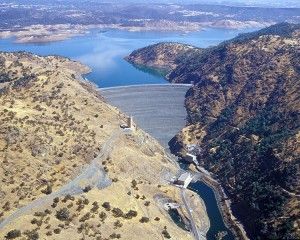Rep. Denham trumps Sen. Feinstein’s call for more water storage
by Wayne Lusvardi | July 24, 2013 11:25 am
Sen. Dianne Feinstein, D-Calif., is calling for more water storage[1] for California. But the storage already exists for much of what is needed. New Melones Dam and Lake, which are under the purview of the federal government, sit half empty due to regulatory overkill. The dam is operated by the U.S. Bureau of Reclamation and is located east of Stockton along the foothills of the Sierra-Nevada Mountain Range.
 [2]
[2]New Melones Dam (Wikimedia)
As a solution, Rep. Jeff Denham, R-Modesto, has proposed H.R. 2554[3]. In the bill’s language, it aims “to increase water storage availability at the New Melones Reservoir to provide additional water for areas served below the reservoir, and for other purposes.” The bill further specifies that none of the added water storage can go toward the dam’s “conservation account,” which already takes most of the water stored during dry years.
New Melones is California’s first “Green Dam”
Melones[4] is a former settlement formed around a ferry terminal along the Stanislaus River in Calaveras County. It now sits submerged under a lake formed by the New Melones Dam built in 1979 mainly for flood control[5] and agricultural irrigation. Water originally designated for farming has mostly disappeared, except in very wet years. The water didn’t disappear from drought but from a series of regulations. An April 9, 2013 Board Letter of the Tuolumne Utilities District[6] explained:
“The Bureau [of Reclamation] has not been delivering the water because the water for delivery to a contractor hasn’t been available from Melones, except in above normal years. The shortage results, not from drought conditions, but from Congress’ enactment of the Endangered Species Act in 1972, from Congress’ enactment of the Central Valley Project Improvement Act in 1991, and the SWRCB’s [State Water Quality Control Board’s] adoption of the Bay Delta Water Quality Control Plan in 1995 and its implementation decision D 1641 in 2001. All of these resulted in required increases in bypass flow from Melones. All of these actions combined have resulted in the Bureau saying that, except in very wet years, all of the yield of New Melones is now required for water quality and fishery flows in the lower Stanislaus and in the Delta and there is no water available for the [irrigation] Project.”
New Melones Dam may now be called California’s, and the U.S.’s, first “green dam.” It is only able to meet its contractual obligations to supply farm water to all recipients during wet years.
Farming and commercial mining losses
Environmental water diversions from New Melones also have caused the Stockton East and Central San Joaquin areas to suffer the greatest shortages of contracted water. In dry years these agricultural districts were shorted more 100,000 acre-feet of water[7].
Part of the dam improvements include a system of pumps costing about $11.3 million in today’s dollars owned and operated by the Tuolumne Utility District to supply the Columbia and Sonora Mining Company[8]. In the current operating regime, the pumps have sat high and dry during three dry years, causing even greater loss of commercial productivity over and above agricultural losses.
Denham’s Bill
Denham’s new bill would require that local irrigation districts be offered a contract to store up to 100,000 acre feet of water in the unfilled portion of New Melones reservoir. The reservoir has a capacity of 2.4 million acre feet of water[9]. That is enough water to irrigate about 800,000 acres, or 1,250 square miles, of farmland for one year. Some 450,000 acre-feet of the water are stored for flood control.
But the reservoir is reported to be often less than half empty[10] due to priority diversion of water to the environment. As of July 6, the California Department of Water Resources[11] reported that New Melones reservoir is at 51 percent of total capacity, but 82 percent of its historical average of 2.0 million acre-feet of water.
The additional water proposed for storage in the reservoir could also be used for water transfers or exchanges for water-short Central Valley farmers; or to provide a source of cold water for migrating fish in dry years.
The Denham bill requires no appropriation of federal funds and no construction of new dams. It would not have significant negative environmental impacts and would help recharge Central Valley groundwater basins. Farmers have offered to pay to park the added water in the reservoir, and water could be made available for the 2014 irrigation season. All that would happen if the bill is passed by Congress.
Denham’s bill offers to drain part of the proverbial swamp of regulations that is keeping farmers, miners and the environment from needed water supplies.
- calling for more water storage: http://www.feinstein.senate.gov/public/index.cfm/op-eds?ID=df2ad233-bcc0-4476-a248-b8ef5b09d9f0
- [Image]: http://calwatchdog.com/wp-content/uploads/2013/07/New-Melones-Dam-wikimedia.jpg
- H.R. 2554: http://www.govtrack.us/congress/bills/113/hr2554/text
- Melones: http://en.wikipedia.org/wiki/Melones%2C_California
- flood control: http://www.mantecabulletin.com/section/160/article/78716/
- Board Letter of the Tuolumne Utilities District: http://www.tudwater.com/agendas/2013/April/4April92013.pdf
- shorted more 100,000 acre-feet of water: http://baydelta.wordpress.com/2009/11/22/new-melones-and-the-stockton-east-controversy/
- Columbia and Sonora Mining Company: http://www.mantecabulletin.com/section/160/article/78716/
- 2.4 million acre feet of water: http://www.usbr.gov/projects/Project.jsp?proj_Name=New%20Melones%20Unit%20Project
- less than half empty: http://www.mantecabulletin.com/section/160/article/78716/
- California Department of Water Resources: http://cdec.water.ca.gov/cdecapp/resapp/getResGraphsMain.action
Source URL: https://calwatchdog.com/2013/07/24/rep-denham-trumps-sen-feinsteins-call-for-more-water-storage/